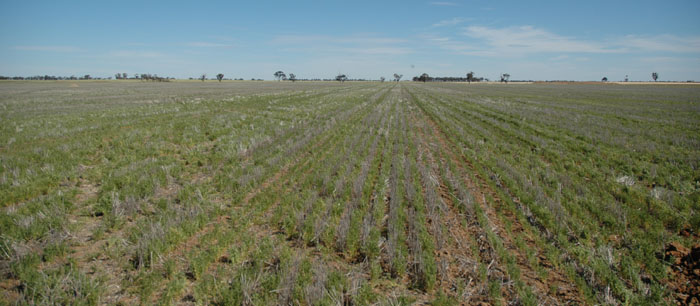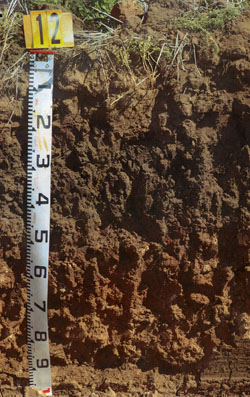WCFA12
Location: Litchfield
Australian Soil Classification: Sodic, Calcic, Brown DERMOSOL
General Landscape Description: Flat Plain.
Site Description: Linear gilgai. Cropping paddock.
Geology: Parna – Woorinen Formation.

WCFA12 Landscape
Soil Profile Morphology:
| Surface Soil |  WCFA12 profile | ||
| A1 | 0-15 cm | Very dark brown (10YR2/3); very fine sandy clay loam; moderate fine sub-angular blocky structure; rough fabric; weak consistence dry; pH 7.9; wavy change to: | |
| Subsoil | |||
| B21 | 15-45 cm | Dark yellowish brown (10YR3/4); light medium clay; strong medium sub-angular and angular blocky structure; rough to smooth fabric; very firm consistence dry; contains very few medium soft calcareous segregations; pH 8.6; clear and wavy change to: | |
| B22k | 45-80 cm | Yellowish red (5YR5/6); light medium clay; strong medium prismatic, parting to strong fine angular blocky structure; rough to smooth fabric; strong consistence dry; soft calcareous segregations common, with very few fine calcareous and manganiferous nodules; highly calcareous; pH 9.3; changing to: | |
| B23 | 80-105+ cm | Light yellowish brown (10YR6/4); medium clay; moderate medium prismatic, parting to medium fine angular blocky structure; rough to smooth fabric; strong consistence dry; contains very few fine calcareous and manganiferous nodules; moderate to highly calcareous; pH 9.2. | |
Soil Profile Characteristics:
pH | Salinity Rating | |||
Surface (A1 horizon) | Slightly Alkaline | Low | Non-Sodic | None |
Subsoil (B21 horizon) | Strongly Alkaline | Medium | Strongly Sodic | Slight1 |
Deeper Subsoil (at 80-105 cm) | Very Strongly Alkaline | High to Very High | Extremely Sodic | None2 |

|
| The surface is non-sodic. The upper subsoil is strongly sodic becoming extremely sodic with depth. | The Boron levels increase with depth, becoming high in the subsoil. | The clay content increases markedly at the surface / subsurface boundary. |
Horizon | Horizon Depth (cm) | pH (water) | pH (CaCl2) | EC dS/m | NaCl % | Exchangeable Cations | |||
Ca | Mg | K | Na | ||||||
meq/100g | |||||||||
A1 | 0-15 | 7.9 | 7.5 | 0.16 | - | 24 | 4.6 | 2 | 0.7 |
B21 | 15-45 | 8.6 | 7.9 | 0.49 | 0.04 | 17 | 12 | 1.2 | 6.6 |
B22k | 45-80 | 9.3 | 8.7 | 1.1 | 0.1 | 6.6 | 17 | 1.7 | 14 |
B23 | 80-105 | 9.2 | 8.7 | 1.3 | 0.14 | 5.6 | 17 | 1.8 | 16 |
Horizon | Horizon Depth (cm) | Oxidisable Organic Carbon % | Total Nitrogen % | Available Boron mg/kg | Field Capacity pF2.5 | Wilting Point pF4.2 | Coarse Sand (0.2-2.0 mm) | Fine Sand (0.02-0.2 mm) | Silt (0.002-0.02 mm) | Clay (<0.002 mm) |
A1 | 0-15 | 1.1 | 0.1 | 2.7 | 29.5 | 15.2 | 22 | 27 | 11 | 37 |
B21 | 15-45 | 0.66 | 0.055 | 8.5 | 35.2 | 25.5 | 18 | 20 | 8 | 50 |
B22k | 45-80 | 0.3 | <0.05 | 30 | 55.3 | 30.7 | 10 | 13 | 7 | 57 |
B23 | 80-105 | 27 |
Profile Described By: Nathan Robinson, Grant Boyle and John Martin (October 2006).


